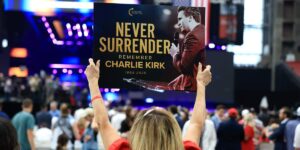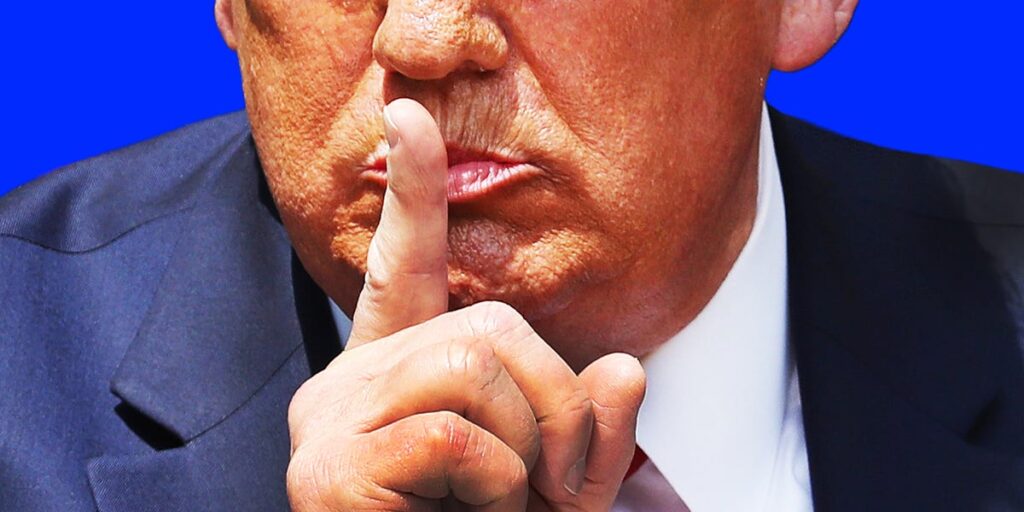When it comes to cracking down on free expression, America has two colorful and distinct traditions. And one is playing out in business right now.
The first might be called the Direct Method: The government brings down the hammer of censorship by criminally prosecuting an individual or business directly for their speech. From World War I through the 1920s, laws like the Espionage Act authorized imprisoning activists and newspaper publishers who circulated anti-war ideas. Earlier, the Sedition Act of 1798 effectively made it illegal to criticize the sitting president, John Adams, resulting in the prosecution of at least 25 Americans.
The second tradition of censorship could be called the Indirect Method, utilizing what First Amendment scholars sometimes call “soft coercion.” In this approach, the government leverages all the creative ways it can to punish speech peripherally — by withholding certain benefits, making regulatory tweaks, or tagging groups with toxic legal designations in national security or the tax code. This tradition came to define the McCarthy-era crackdown on Communist sympathizers, which reached its zenith in the 1950s.
The suspension this past week of Jimmy Kimmel by ABC — at the apparent behest of FCC Chairman Brendan Carr — bears the features of soft coercion. Expressing displeasure at Kimmel’s characterization of Charlie Kirk’s assassin, Carr appeared on a podcast to announce that he would consider regulatory punishments for ABC if it didn’t remove Kimmel from the air, before adding, “We can either do this the easy way, or the hard way.” ABC announced Kimmel’s suspension hours later.
What followed was a predictable ritual. As a nationwide chorus of political and business icons — from Barack Obama to Joe Rogan to former Disney CEO Michael Eisner — raised their voice in defense of free speech, MAGA partisans charged Democrats with bad faith, claiming that activists were merely being served their own medicine of “consequence culture.”
Beneath MAGA’s reversal is a point worthy of reflection. The First Amendment only prohibits censorship by government, not by private businesses. Nevertheless, corporations and universities, no less than government bureaucrats, can also practice soft coercion. “Government is not the only thing that can make you unfree,” Pete Buttiegieg observed when running for president — so can “your neighbor,” your “cable company,” and an employer. It’s when these two forces conspire that the result, historically, spells trouble.
The recruitment of private actors for government ends is the marquee feature of soft coercion. And in Carr’s remarks, several scholars have identified the same DNA signature that came to define the Red Scare of the 1950s. “This is clearly a case of unconstitutional threats and coercion of a private actor,” Evelyn Douek, a professor at Stanford Law School who teaches the First Amendment, wrote by email. “Like the McCarthy Era, the government is relying on private actors to carry out its speech repression on its behalf.”
In the 1950s, federal and state governments found creative ways to induce private institutions — Hollywood studios, unions, and universities — to purge or blacklist unwanted speakers. Less appreciated, but no less vast, was the pressure campaign waged on private industry. As historian Ellen Schrecker describes in her book “Many Are the Crimes,” the country’s corporate behemoths in manufacturing and engineering — GE, Bethlehem Steel, RCA, Lockheed, General Motors, and others — were enlisted to cooperate with FBI and Pentagon loyalty screening programs, effectively monitoring the political views of thousands of employees.
In some respects, we’re back in the 1950s, not with a Red Scare, but a Woke Scare.
While some executives resisted somewhat, such as those at Ford, the overwhelmingly majority complied. The auto giants, particularly dependent on government defense contracts, were among the most galvanized by threats of investigations or lost business. GM officials repeatedly testified before Congress, required political loyalty oaths from unions, established a “loyalty and security” office, and preemptively fired workers flagged in reports by HUAC. In 1958, across all areas of employment, estimates suggest as many as one in five of Americans were subject to some form of loyalty review.
In some respects, the second Trump administration’s own efforts mirror this 1950s-era paradigm — not a Red Scare, but a Woke Scare. Under the auspices of reigning in far-left ideology, the administration has implemented a concerted crackdown on speech by foreigners (should they write an impolitic op-ed), private universities (should they fail to make ideological adjustments, like firing Del staff), and law firms (should they advocate insufficiently for government-approved causes).
As for broadcasters, Carr’s rationale may be rooted in the First Amendment concept of “government speech”: while it can’t interfere with others’ speech, government doesn’t have to spend its money on speech it dislikes — and these are the government’s licenses, after all. That argument, too, echoes 1950s-era tactics of soft coercion: Here, as then, the administration hasn’t made it criminal to advocate left-wing causes, teach left-wing ideas, or litigate for left-wing clients — but if you do, you stand to lose your green card, your research funding, your security clearance, and now, your broadcast license. Corporate America has taken heed of this message, from Target rolling back its DEI policies, to Paramount paying Trump a $16 million settlement of his lawsuit over the editing of a “60 Minutes” interview with Kamala Harris.
While vast, the Trump administration’s practice of soft coercion is also easily comprehensible. It follows three basic techniques — the Heckler’s Veto, jawboning, and the use of vagueness — which collectively nudge or compel Americans and their employers to suppress certain types of speech on the administration’s behalf.
The first tactic is known as the “Heckler’s Veto” — in which the government outsources the task of censorship to crowds of private citizens, then looks the other way while the mob wreaks havoc. This past week, while guest-hosting “The Charlie Kirk Show,” Vice President JD Vance called on millions of Americans to take action. “When you see someone celebrating Charlie’s murder, call them out,” Vance said. “And hell, call their employer.”
It is bad morals to celebrate someone’s murder. But it is bad civics for a head of state to enforce morals by punitive threat. The illegality of such a scheme would be obvious if Vance had made this request not of private citizens, but of the FBI. Vance’s exhortation recalls the FBI’s loyalty program but in reverse: a national snitch line, in which private citizens monitor their bosses. As Douek put it: “The government is trying to use its power to force private actors to do for it what it couldn’t do directly — suppress protected political expression.”
The second tactic is “jawboning.” The term refers to a strategy in which government officials improperly lobby a private actor to remove or censor third-party speech, often using vague or implied threats. Until recently, it was Democrats who had been tarred with jawboning. In 2024, a federal court ruled the Biden administration had inappropriately pressured Facebook and Twitter to combat vaccine-related and other misinformation. Carr’s implied threat to ABC maps with laser precision onto the same jawboning offense.
The third and final tactic of soft-coercion censorship is the use of vagueness. Instead of writing laws that articulate clearly what speech is banned, a purposefully vague law (or executive order) leaves doubt as to what speech is legal and which is criminal. Amid this confusion, citizens come to live under perpetual uncertainty that their speech — the next text, tweet, or Slack message — might or might not invite the wrath of criminal prosecution. Vagueness is a First Amendment violation because of its unusual power to achieve widespread self-censorship not by fiat, but doubt — the origin of the concept of “chilling” speech.
Vagueness appears to be the cornerstone of the administration’s censorship strategy — the entirety of which could be conceived as one massive, rolling vagueness violation. Consider two recent examples: A $15 billion lawsuit against The New York Times for defamation (dismissed this week by a federal judge as “improper and impermissible”), and an executive order banning flag burning (a black-letter First Amendment violation). But why bring lawsuits and executive orders that can’t be enforced?
In American corporations’ 10-year course in political submission, the left was their first teacher.
These maneuvers have been described as clear attempts to make Trump’s dissatisfaction plainly understood. In reality, the censorship campaign is in many ways seemingly intended not to be understood — designed not to clearly prohibit speech but instead invite the question whether it is. Trump strikes a bargain with law firms, for example, but the agreements aren’t publicly written down, and no one publicly knows who has agreed to what. Trump bans the Associated Press from the White House grounds for using the phrase “Gulf of Mexico,” but grants access to other outlets that use the same phrase, leaving lawyers to speculate about Trump’s motives in court. Even Carr’s comments this past week resound in the Kafkaesque, accusing ABC of a vague failure to serve “the public interest.” These lawsuits and executive orders serve a similar purpose: to signal loudly that it doesn’t credit the First Amendment rules we have come to accept as ironclad — and to invite the next journalist, or activist, to think twice about which free speech guarantee he might discard next.
“Unlike the McCarthy Era, the list of views that are on the forbidden list is much longer and more amorphous and growing every day,” observes Douek. “This is not just about suppressing Communism, for example — it seems like it has become dangerous to criticize the government or its allies in general.”
There is one crucial remaining factor that explains the success of Trump’s soft coercion: the fecklessness of the institutions — law firms, universities, now broadcasters — that have capitulated to it, sometimes with breathtaking speed. With this phenomenon, we are reckoning with the casualties of a tragic misadventure that continues to haunt our public life: the abject failure of mainstream Democrats over the last decade to defend passionately the values of free expression as a matter of first principle. By acquiescing to progressives who believed otherwise, the liberal and conservative custodians of these institutions weakened the resolve of their leaders to learn the vocabulary of liberal resistance. Inadvertently, they softened the institutional terrain for MAGA’s eventual Viktor Orbán-style conquest. It takes years of incessantly kowtowing to offended mobs to acclimate to capitulation. In American institutions’ 10-year course in political submission, in other words, the left was their first teacher.
Now, as people begin building a renewed case for free speech, they should keep two principles in mind, both drawn from the lessons of the 1950s. The first comes from Arthur Koestler. “You can’t help people being right for the wrong reasons,” the Austro-Hungarian journalist said in 1949. In the coming months, left-wing activists will find themselves making points about free expression that match verbatim the past words of Tucker Carlson and Andrew Tate — a fact they must be prepared to credit and embrace. Anything less, warned Koestler, will poison their cause with the most lethal affliction any argument can suffer: “Lack of self-confidence.”
The second principle comes from Supreme Court Justice William O. Douglas. In 1951, Douglas immediately identified the threat of soft coercion, warning that America would soon “enter dangerous territory to the liberties of every citizen.” He also articulated the phenomenon that explains the First Amendment’s political staying power: the confidence — faith, really — in the reasoning powers of the American public, and the inherent esteem it conveys toward one’s countrymen. Famously, Douglas pronounced a “confidence in the ability of our people to reject [the] noxious,” whether in literature, theology, or politics. Today, a coalition of Americans must find a way to project certainty in the reasoning capabilities of every American: a new kind of public faith. This will remain true even if that certainty is later proven to have been tragically misplaced. That is, after all, what faith requires.
Benjamin Wofford has written for Wired, Politico Magazine, Vox, and Rolling Stone, and is a graduate of Stanford Law School.
Business Insider’s Discourse stories provide perspectives on the day’s most pressing issues, informed by analysis, reporting, and expertise.
Read the full article here
















